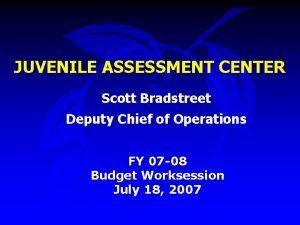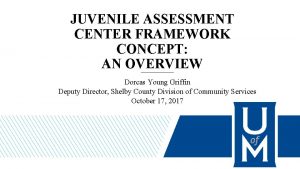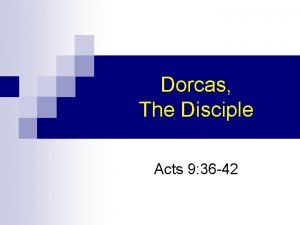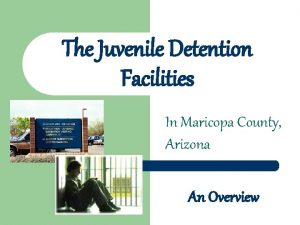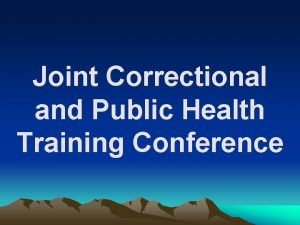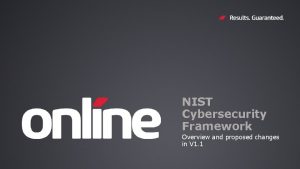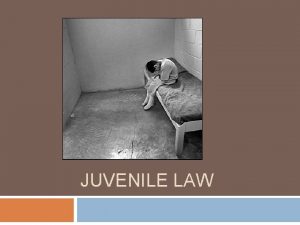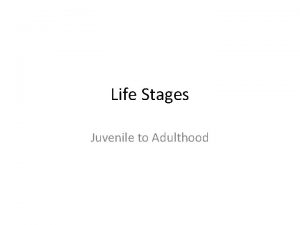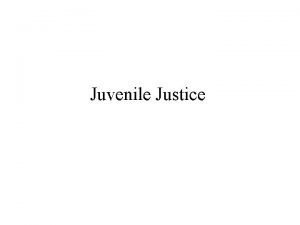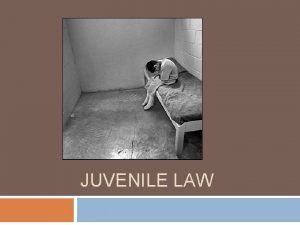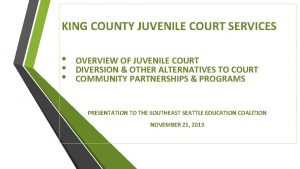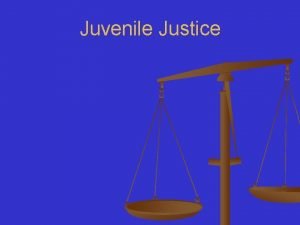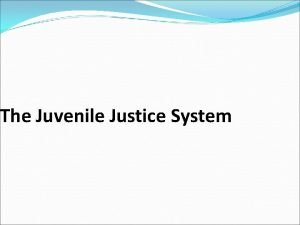JUVENILE ASSESSMENT CENTER FRAMEWORK CONCEPT AN OVERVIEW Dorcas



















- Slides: 19

JUVENILE ASSESSMENT CENTER FRAMEWORK CONCEPT: AN OVERVIEW ___________ Dorcas Young Griffin Deputy Director, Shelby County Division of Community Services October 17, 2017

Why is an Assessment Center Important? o 4, 829 juvenile summonses issued in 2015, 3, 906 summonses were issued in 2016 o 938 youth detained in 2015, 871 youth detained in 2016 o 1, 166 youth diverted from detention based on their Detention Assessment Tool (DAT) score in 2015, 1, 085 in 2016 o 4, 684 of offenses in 2016 with eligible offenses o Cost of $150. 00 per day to detain of youth

The Juvenile Assessment Center Model • Provides critical prevention and early intervention assessment and case management services to youth and their families who are exhibiting at-risk behaviors at home, at school, and/or in the community • Incorporates numerous services and programs in an coordinated effort by different entities • Increases accountability of providers that serve justice involved youth and at-risk youth, their families, and the community at large • Provides youth with a greater array of services, at a reduced cost to operate and with more positive outcomes

Framework Foundations • Juvenile Assessment Center, Youth Assessment and Resource Center, JAC vs. YARC • Juvenile Summons Program • Framework ≠ Plan

Juvenile Assessment Working Group • • • Formed January 2017; part of the Operation: Safe Community Crime Plan Includes representatives from various government, educational and community agencies serving youth and families Monthly meetings Extensive best practices research Site visits to model programs in other jurisdictions (including Miami, FL and Denver, CO Engagement of other juvenile justice stakeholders and youth

Goals of Assessment Center To divert as many youth as possible, consistent with public safety, from entering or going deeper into the juvenile justice system.

Goals of Assessment Center To enhance public safety through early intervention, comprehensive assessment, and referral to supportive services and positive strategies tailored to address each youth and family’s individual needs.

Goals of Assessment Center To increase effectiveness in the use of limited community resources through the elimination of duplication of effort and enhanced accountability.

Goals of Assessment Center To provide a point of entry for justiceinvolved youth, allowing law enforcement to return to their other duties in a timely manner while ensuring appropriate follow up for youth.

Goals of Assessment Center To serve as a resource and facilitate better relationships between law enforcement, agencies serving youth, families, and the community.

Who Can Refer to the Assessment Center? Shelby County YARC Law Enforcement Families and Community

Community Referral Assessment Program Youth, family, or school requests assessment YARC intake and assessment (youth and family) Coordination and referral to services YARC case management and follow-up

Law Enforcement Referral Program Youth contact with law enforcement LEAP to determine appropriate referral for youth No Referral to YARC Youth is transported directly to juvenile detention (ineligible offense, DAT score >19) Level 1— Law Enforcement Referral – No Transport Youth is advised of services and referral to YARC suggested within 48 hours of contact Level 2— Law Enforcement Referral- No Transport Youth is given summons (for eligible offense) and is given a mandatory referral to YARC within 48 hours of contact Level 3— Law Enforcement Referral- Transport Level 4— Law Enforcement Referral- Transport Youth is given summons for YARC -eligible offense and is transported to YARC Youth does not commit YARCeligible offense, but law enforcement determines need for DCS intervention

Law Enforcement Referral Process Youth presents to YARC (mandatory referral or transport by law enforcement) Youth and family refuse services Intake specialists (Sheriff’s Office) verify youth’s eligibility for YARC Youth provided initial screening and assessment services Summons Review Team processes summons for pending status until completion of assessments, intervention plan and follow up programming Youth and family advised of options available to them through the YARC Youth and family receive comprehensive case management and referrals to appropriate services (internal and external) Youth follow plan to completion, receive ongoing follow-up by YARC staff Summons status moves from pending to fully diverted Youth and family accept diversion services and develop intervention plan Youth receives follow-up supports by YARC staff up to 12 months

Key Features of the Assessment Center • Diversion of charges for assessment center eligible offenses, with no resulting court involvement or juvenile record. • Mental health and trauma assessments for youth and families • Individualized assessment of history and needs for youth and families • Individualized intervention plans for youth and families • Various co-located community-based services will be available onsite • Peer supports • Youth mentor opportunities • Specialized reentry services for youth

Benefits of the Assessment Center • • • Offers opportunity to receive services that address underlying causes of delinquency Provides a nonthreatening, inclusive atmosphere for those parents and/or non‑system youth simply looking for information Increases efficiencies for officers; custody exchange for law enforcement and other assessment center models ranges from 6 to 12 minutes Reduces recidivism of youth offenders Provides preventive assessment and services, as well as pooling of resources to save taxpayer dollars Offers trauma-informed, evidence-based programming resulting in better outcomes for youth

How Will Success Be Measured? 1. Reduction in number of juveniles who repeat delinquency, status offenses, or criminal acts 2. Reduction in the number of youth entering the juvenile justice system 3. Reduction in number of juvenile court referrals 4. Reduction in the rate of juvenile disproportionate minority contact 5. Increase in number of juveniles and families connected to community-based services 6. Decrease in the time and cost spent by law enforcement related to juvenile delinquency or status offenses 7. Time (and cost) savings for law enforcement in processing youth committing delinquent acts

Further Considerations • Youth advisory group How will the youth voice be formally integrated into ongoing planning and implementation of the assessment center? • Respite care for youth Could this space also include some respite housing for youth who need a cooling-off period, runaways, or those who are awaiting DCS placement? • Disproportionate minority contact (DMC) Are there any other implications of this center with the issues of disproportionate minority contact, due process, or equal protection that need to be considered before designing this center? Are there any potential unintended consequences or unexpected adverse impacts by the presence of the assessment center?

Next Steps • • • Schedule further community input opportunities for framework between October and December Establish new moniker for the YARC Implement legal authority or official policy change of law enforcement to bring youth with a summons to the assessment center site Identify funding sources and develop budget for assessment center Pilot implementation of assessment center in late Spring 2018
 What are the elements of a system of care
What are the elements of a system of care Orange county juvenile assessment center
Orange county juvenile assessment center Dorcas young griffin
Dorcas young griffin Acts 9 36-42
Acts 9 36-42 Dorcas in the book of acts
Dorcas in the book of acts O que significa dorcas na bíblia
O que significa dorcas na bíblia Sef juvenile detention
Sef juvenile detention Drk juvenile center
Drk juvenile center Seminole juvenile detention center
Seminole juvenile detention center Spring framework overview
Spring framework overview Eylf meaning
Eylf meaning Nist cybersecurity framework overview
Nist cybersecurity framework overview Contact center presentation
Contact center presentation Dispositional framework vs regulatory framework
Dispositional framework vs regulatory framework Theoretical and conceptual framework
Theoretical and conceptual framework Conceptual and theoretical framework
Conceptual and theoretical framework Conceptual framework theoretical framework
Conceptual framework theoretical framework Dispositional framework vs regulatory framework
Dispositional framework vs regulatory framework Conceptual framework vs theoretical framework
Conceptual framework vs theoretical framework What is your real self and ideal self
What is your real self and ideal self

